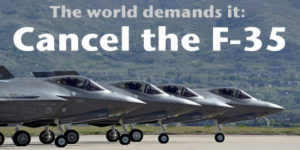The F-35, the Covid stimulus bill, and Congress’s unbalanced priorities
Link to sign Roots Action: Petition to Cancel F-35 Program

March 8, 2021, 4:36 AM CST
By Hayes Brown, MSNBC Opinion Columnist
“Is it weird to hate a plane? I don’t mean in the flying or air travel sense; I mean a plane. Specifically, the F-35 II Lighting, aka the Joint Strike Fighter.
The F-35 is meant to be the United States’ go-to fighter plane for the next three decades at least. In reality, it’s a money pit. It is the very definition of a boondoggle. And in the almost 20 years since the Pentagon first signed a contract to buy F-35s from Lockheed Martin, the cost for each one of these planes can be used as a standard unit for measuring how overprioritized the military is compared to things like ending poverty and otherwise alleviating economic misery in the U.S.
To wit: Last Friday, the Senate spent hours debating the details of President Joe Biden’s $1.9 trillion stimulus bill, including how long people who are still unemployed after over a year thanks to Covid-19 really need a few extra weeks of help. Sen. Joe Manchin, D-W.Va., finally agreed to vote with the rest of his caucus on an amendment that would extend emergency federal unemployment benefits with a few caveats.
His vote’s price: On top of the previous compromise — which left the federal benefit at $300 extra per week instead of the $400 weekly in the House bill — he got the extension to expire on Sept. 6, a month earlier than other Democrats wanted. The amendment also made the first $10,200 in benefits tax-free (for households making up to $150,000 in 2019, another Manchin demand).
According to the Center for a Responsible Federal Budget, extending federal unemployment benefits would cost around the equivalent of $24.6 billion per year over the next decade in the version of the bill the House passed Feb. 26. Back-of-the-envelope math (which, if you’re a congressional budget staffer who can correct me, please hit me up) shows that by reducing the length of the program, the Manchin deal would save about $5.4 billion per year. That sounds like a lot — until you realize that Congress allocated $9.1 billion to buy 93 more F-35s in the current fiscal year. And that’s just the planes it bought last year. The year before that, Congress allocated $10.9 billion for 90 more of them.
When the stealth fighter was announced, the total cost from development to production was supposed to be $200 billion. However, “[i]n the 19 years since that announcement, total program costs have doubled to approximately $400 billion,” the Project on Government Oversight’s Dan Grazier wrote in October. “When all the operating costs for the planned fleet are calculated across the program’s expected 50-year lifetime, the American people will spend an estimated $1.727 trillion.”
All of that would be frustrating, but here’s what makes it truly enraging: It’s not a very good plane.
Over the course of its deployment, the F-35 has been grounded more times than a troubled teen. In a fit of irony, the F-35 Lightning II was deemed unable to fly near actual lightning after a problem was discovered that could cause it to explode lightning struck. As of January, the plane “remains marred by 871 software and hardware deficiencies that could undercut readiness, missions or maintenance,” Bloomberg News reported. (None of them are the kind that would threaten the pilot or the aircraft, Lockheed said in a statement to Bloomberg.)
I’m not alone in thinking this is absurd. Rep. Adam Smith, D-Wash., chair of the Armed Services Committee, said as much Friday during a conversation with the Brookings Institution’s Michael O’Hanlon.
The Manchin deal would save about $5.4 billion per year. That sounds like a lot — until you realize that Congress allocated $9.1 billion to buy 93 more F-35s in the current fiscal year.
“We reward people for process and not results. The failure we wind up tolerating is failure on a massive fricking scale: Think F-35,” Smith said when talking about how messed up the Pentagon’s procurement plans are. “For what we have spent in terms of what we’ve gotten back, it’s just painful, it just hurts. And the problem Is that there’s not an easy way out of it.”
“I flinch when you give me the ‘oh, seems to be working better now,'” he said later in the conversation. “But I want to stop throwing money into that particular rathole.”
Smith argued that while getting rid of the program entirely isn’t an option, the U.S. has to consider other jet designs to find “something that doesn’t make us have to rely on the F-35 for the next 35 years.”
So, you may ask, given all of these problems and how much it costs, why is Congress insisting that we buy even more of these planes than the Trump administration asked for in its budget requests? And why is this easier to justify than spending money to help people who are out of work in a pandemic?
Well, unfortunately, while the F-35 has the bipartisan Joint Strike Fighter Caucus to whip members’ support on behalf of the plane, there’s no similar caucus for the unemployed. There’s also a political edge to these decisions, as military funding is considered an easy win for members of both parties to show off to their voters. That dynamic is why you saw Congress continue to buy Abrams tanks for the Army after the Army basically begged it to stop buying tanks.
Members of Congress from both parties need to realize that “it’s not their job to pump as much money as is humanly possible into their districts,” Smith told O’Hanlon.
He’s right. There’s also no reason to treat the military budget as a sacred totem that will bring doom upon the nation should it ever happen to shrink. We’re out here haggling over a few billion dollars that are dwarfed by how much this country spends on national defense every year. Congress’ priorities are misaligned, and, much like the F-35, that just won’t fly right now.”

